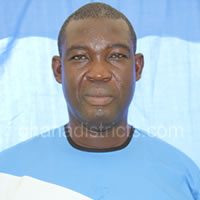Micro-District Economy
Occupational Distribution
The Shai Osudoku District Assembly is largely rural. The predominance of rural population reflects in the occupational distribution with agriculture as the dominant occupation. Previous baseline survey shows that agriculture (crop/ livestock farming, and fisheries) is the major activity in the district, employing 58.6 per cent of the people. Trading is the next largest employer, with 22.1 per cent of the people engaged in trading. Even as a secondary activity as shown in Table 1.8, agriculture still dominated.
The statistics indicate that despite being within the Greater Accra Region, which hosts the National capital, the urban influence of Accra, in terms of occupational characteristics has not penetrated the district so much. The occupational structure in the district is, however, almost equal to the national average of 55 percent in the agricultural sector, indicating that the country as a whole is still non-industrial (Manufacturing). However since the 2002-2005 plan a few commercial farms has been established in the district which is worth mentioning .The relocation of the Golden Exotic farms (a 3,000 hectares banana plantation of which close to 800 hectares has been planted) has broken new grounds in agriculture. Other gains includes the Tropo farms a 5 hector fish farm the Volta Estates, Annapunna Salt and other small scale salt mines along the coast.
Fishing which would have been another big employer, given the presence of the River Volta and Atlantic Ocean, employs only 6.4 percent of the people. The sub-sector still does not attract most employable youth due to the technology currently employed, which is labour-intensive. The low employment figure for industry (4.5 percent) explains the agrarian nature of the people hence the general absence of industries in the district. Industry as a full-time occupation is rare in the district. Workers constitute only about 8.4 percent of the workforce.
The district also abounds in natural resources that could be harnessed for increasing production and gainful employment. This would be achieved through the District Assembly’s effort at creating the enabling environment for private sector participation in the provision of goods and services and gainful employment.
Areas that could be focused on are:
The development of the tourism sector, development of the salt industry, which is favourable due to high temperature which promotes rapid evaporation and crystallization, the development of fish industry and the President’s special initiative on cassava production. Much attention will also be focused on the large-scale cultivation of sugarcane for commercial uses.
Leading Sector
Although agriculture dominates the district, the leading sectors in terms of provision of revenue to the district Assembly and remunerations to workers are the quarries. Financial reports from the District Assembly indicate that the highest contribution to internally generated revenue comes from fees and fines. This is followed closely by business operating permits. This implies that the District Assembly would need to provide the enabling environment and infrastructure to attract industrialists and other economic activities into the District in order to widen the revenue base of the District. The District would have to devise strategies to widen the scope of revenue collection.
Analysis of the District Economy
The District ranks among the most deprived districts in Ghana though it has a huge untapped potential for development. Data from the Ghana Living Standards Survey (GLSS 4) points to the fact that about three out of every ten persons within the potential labour force are employed (31.3%). In spite of this, poverty is endemic in this district. Cautious estimates from the same survey indicate that 20% of the population is poor by national standards.
A significantly large proportion of the active labour is in agriculture and its related employment. The GLSS 4 indicates that 48.5% of the active labour force is in agriculture.
The District is noted for the production of fruits such as mangoes, pineapple, and banana. In addition to this, rice production and aqua culture are practised in the Asutsuare area. As the district lies within the Accra Plains it is also noted for animal production with cattle, goats and poultry rearing being the leading activities. Production is mostly on small scale and organised around households though there are a few large-scale enterprises. This sector has experienced virtually no technological innovation and capitalisation as farm sizes remain small and simple tools and traditional methods are used.
Employment in industry and commerce trail agriculture as only 22.1% and 4.5% respectively of the active population is in respective sectors. In addition to this 8.4% are in formal employment. This is to be expected as there are only a few large industrial establishments in the district and the current spatial distribution employment patterns and income does not present any competitive advantage for entrepreneurs to want to establish ventures there. However, the potential exists for such industries if the right mix of policies, projects and programmes targeted at agricultural productivity in the district such as the current MCA-GH compact are instituted.
In sum, the correlates of income poverty in the District are high unemployment and inadequate investment in agricultural production and agro-business. In the Millennium Challenge Account Compact, a mix of strategies that tie the provision of economic and social infrastructure to certain agriculture hubs have been identified as part of a wider strategy to create wealth through increased activity in agro business and enhanced competitive advantage for local fruit and vegetable farmers in a designated agriculture zone in the district. It is expected that the interventions in this agricultural zone such as the financial support for target farmers; and the construction of the pack houses at Agomeda will provide employment and encourage the production of mangoes and other perishable commodities for the regional and international markets. This is expected to positively impact on the poverty profile of the district.
Investment and Business Potential
The Shai Osudoku District has huge potential for investment in various sectors. The extensive road network linking its major towns would facilitate this. So would its proximity to both Accra and Tema, and its natural and human resources. The district is particularly well placed for investments in real estate development, agriculture, tourism and industry.
There are several reasons why the Shai Osudoku District has a high potential for real estate development. One is that, the district is the closest to the Accra – Tema Metropolis where a high, unsatisfied demand for housing currently exists.
Increasingly, the district is being seen as a suitable suburb of the metropolis itself, from which workers and entrepreneurs can conveniently commute to their places of work and back. Already, the District Assembly has identified 42,000 plots, spread over 10,500 acres within the Dodowa and Afienya areas for immediate development. As strategically positioned as the district is, land prices are still competitive enough to make investment in the real estate sector very attractive.
Besides this, there is wide availability of building materials such as sand, gravels and stones within the areas where this land is situated. In the agricultural sector, about 90% of the total land area comprises arable land but only 35% of this is currently under cultivation. Studies have shown that the entire district is suitable for food crops like cassava, maize and vegetable.
There is a mango seedling nursery at Dodowa, established by the Ministry of Agriculture in 1972, where varieties like Kent, Keith, Julie, Jaffna, Palmer and Hader have been introduced. There is, thus, immense potential for mango plantation for the export market and a vast stretch of land at Kordiabe with appropriate characteristics and topography, which has been earmarked for such a project.
About 75% of the arable land in the district, mainly savannah grassland, is very suitable for livestock rearing. Currently, the district has the largest population of cattle in the Greater Accra Region. The district has lots of potential for industrial production in terms of availability of land, labour, a wide spectrum of industrial raw materials and the existence of sufficient support infrastructure and service
For instance, the district has substantial oyster shell deposits suitable for lime, paints and terrazzo, clay deposits for pottery, brick and tiles, and sand for building construction. Salt mining is highly viable and lucrative in the district’s coastal areas.
Private Sector Competitiveness
- Reclamation of 40 acres of farmland lost to sand winning annually
- Provision of irrigation facilities for all year farming
- Strengthen extension and veterinary services
- Promote fish farming (aquaculture) and supply of fish inputs
- Promote large scale farming (mango, pineapple, pepper, etc)
- Facilitation of the establishment of post-harvest infrastructure
- Expansion of educational infrastructure and services
- Expansion of health infrastructure and related services
- Increasing accessibility to the supply of electricity in the district
- Expansion of market infrastructure
- Increasing accessibility to provision of potable water and improved sanitation
- Expansion of feeder road infrastructure improvement of existing tourist sites in the District
Financial Institutions
The Banking Industry
The Banking Industry in the District is not yet developed as expected judging from its proximity to major cities like Accra and Tema. The District however, can boast of two Rural Banks - Shai Rural Bank at Dodowa with a branch at Adenta and the Dangme Rural Bank at Prampram which has established branches in Old Ningo and Asutusare.
The clientele of the two Rural Banks can be found in the following sectors of the economy:
1. Agriculture (crop farming and livestock production).
2. Transportation (procurement of vehicles and spare parts)
3. Petty Trading and
4. Small- scale (mostly agro-based) industries
Current interest rates are at par with existing industry averages and collaterals are not limited to land title deeds but other securities including bonds, treasury bills and stocks.
The two Banks allocate most of their loanable funds to the agricultural and cottage industries sub-sectors, with 45% going to the agricultural sub-sector, 30% to cottage industries and 25% to other sectors.
In spite of the current low levels of population and incomes in the District, the potential for better developed banks with their attendant advanced services is huge. As the cities of Accra and Tema are fast spreading into the District, the potential for better developed banks is great.
There is therefore a great need for the establishment of more business-oriented or commercial banks to meet the growing population’s demand for banking service.
Date Created : 11/24/2017 2:18:58 AM






 facebook
facebook twitter
twitter Youtube
Youtube TOLL FREE 0800 430 430
TOLL FREE 0800 430 430 +233 593 831 280
+233 593 831 280 GPS: GE-231-4383
GPS: GE-231-4383 info@ghanadistricts.com
info@ghanadistricts.com Box GP1044, Accra, Ghana
Box GP1044, Accra, Ghana